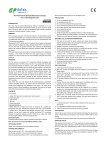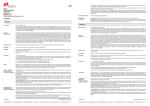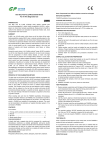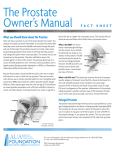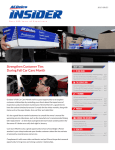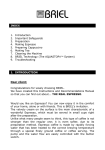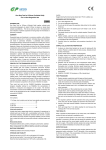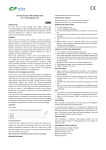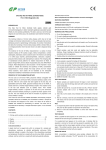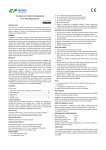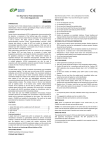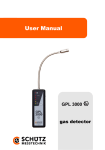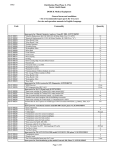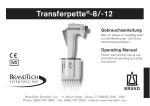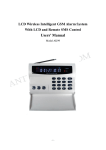Download See More - AD MEDICUM DOO
Transcript
One Step Test for PCT (Colloidal Gold) For In Vitro Diagnostic Use Manual INTENDED USE One Step Test for PCT (Colloidal Gold) applies colloidal gold immunochromatography to detect Procalcitonin (PCT) in serum, plasma or whole blood samples quantitatively. The test is used as an aid in the assessment and evaluation of patients suspected of bacterial infection, trauma or shock. SUMMARY PCT is a peptide precursor of the hormone calcitonin, the latter being involved with calcium homeostasis. It is composed of 116 amino acids and is produced by parafollicular cells (C cells) of the thyroid and by the neuroendocrine cells of the lung and the intestine. Measurement of PCT can be used as a marker of severe sepsis and generally grades well with the degree of sepsis, although levels of PCT in the blood are very low. PCT has the greatest sensitivity and specificity for differentiating patients with SIRS from those with sepsis. PCT levels may be useful to distinguish bacterial infections from nonbacterial infections. It has shown that PCT may help guide therapy and reduce antibiotic use, which can help save on cost of antibiotic prescriptions and drug resistance. PRINCIPLE OF THE EXAMINATION METHOD The test uses a monoclonal anti-human PCT antibody conjugated with colloidal gold and another monoclonal anti-human PCT antibody coated on the test line. After the sample (serum, plasma or whole blood) has been applied to the test stripe, the gold-labeled monoclonal anti-human PCT antibody binds to the PCT in sample and forms a marked antigen antibody complex. This complex moves to the test card detection zone by capillary action. Then marked antigen antibody complex is captured on the test line by the monoclonal anti-human PCT antibody. The color intensity of the test line increases in proportion to the amount of PCT in sample. Then insert test card into the FIA8000 Quantitative Immunoassay Analyzer (hereafter referred to as FIA8000), the concentration of PCT is measured and displayed on the screen. The PCT concentration is stored in the FIA8000 and is available on demand. The result can be transmitted to the lab or hospital information system, if it is connected to FIA8000. CONTENTS A kit contains: 1. Foil bag, which contains one test card, one pipette and one desiccant ······························································· 25 2. Manual ················································· 1 3. SD card ··············································· 1 4. Blood sample diluent ······························· 1 A test card consists of: A plastic shell and a reagent strip which is composed of a sample pad, a colloidal gold pad (coated with a gold-labelled anti-human PCT monoclonal antibody), nitrocellulose membrane (the test line is coated with another anti-human PCT monoclonal antibody, and the control line is coated with rabbit anti-mouse IgG antibody), absorbent paper and liner. Blood sample diluent: Phosphate buffered saline, proteins, detergent, preservative, stabilizer. Note: Components from different batches cannot be exchanged. MATCHING EQUIPMENT FIA8000 Quantitative Immunoassay Analyzer STORAGE AND STABILITY Store the test card at 4~30 oC with a valid period of 24 months. Use the test card immediately once the foil bag is opened. Store the blood sample diluent at 0~30oC with a valid period of 24 months. Suggest storing the blood sample diluent at 2~8oC for a better use. WARNINGS AND PRECAUTIONS 1. For In-Vitro diagnostic use. 2. For use by healthcare professionals. 3. Do not use the kit beyond the expiration date printed on the outside of the box. 4. Keep the test card in the sealed pouch until ready to use. Do not reuse the used cards. 5. The pipette should not be used for multiple samples. Discard it after single use. 6. Patient samples, used test cards and pipettes may be potentially infectious. Proper handling and disposal methods should be followed in accordance with local regulations. 7. Carefully follow the instructions and procedures described in this manual. SAMPLE COLLECTION AND PREPARATION 1. A serum, plasma or whole blood sample is required for testing with this product. Serum or plasma is a better option for test accuracy. Samples should be free of hemolysis. 2. Heparin needs to be used as anticoagulant. 3. Serum or plasma can be directly used as test samples. If choose whole blood as a test sample, it should be diluted with blood sample diluent before using. 4. If testing cannot be completed immediately, the serum and plasma sample should be stored up to 7 days at 2~8oC or stored at -20oC for 6 months (whole blood sample should be stored up to 3 days at 2~8oC) until it can be tested. 5. Samples must be recovered to room temperature before testing. Frozen samples are required to be completely thawed and mixed thoroughly prior to testing. Minimize repeat freeze-thaw cycles to less than 3 times for tested samples to acquire accurate data. 6. Avoid heating the samples, which can cause hemolysis and protein denaturation. 7. SAMPLE VOLUME: 120 μl serum, plasma or whole blood. TEST PROCEDURE 1. Restore samples, sealed test-card foil bags and blood sample diluent to room temperature before using. Open the foil bag, label cards with numbers and use the test cards immediately. 2. Confirm SD card lot No. in accord with test kit lot No.. Perform “QC SD” operation (Details refer to 8.3.1 of FIA8000 User’s Manual) when necessary. 3. Take 120 μl sample by transferpette (Pipette can be used in emergency, the sample volume is 4 drops.), drop vertically to the sample port on the test card (when testing whole blood samples, one drop blood sample diluent should be added after loading 120 μl whole blood on the card). Wait for 15 minutes, insert the card immediately into FIA8000 and press "OK" button, the test card can be detected and the result will be printed automatically. Note: 1. It is required to perform “QC SD” operation when using a new batch of kits; Only one “QC SD” operation is required for the same batch. 2. Assure of card side towards FIA8000 is correct and insert the card completely. 3. Don’t wait longer than 15 min before reading the card because the readings after 15 min won’t be accurate. TEST RESULTS When a purplish-red band appears in the control area, use the FIA8000 to analyse the test card and get a quantitative result. If no purplish-red band appears in the control area, it indicates that the operation is incorrect or the test card has past its expiry date. In this case, please read the manual again carefully and use a new test card to try again. If the problem persists, please stop using all products of the same batch immediately and contact with your supplier. EXPECTED VALUE PCT concentration is determined using samples obtained from 500 apparently healthy individuals. The 99th percentile of the concentration for PCT is 0.1 ng/ml. If the concentration of PCT is less than 0.1 ng/ml, it can be estimated as normal. The research of the ACCP/SCCM (American College of Chest Physicians /Society of Critical Care Medicine) showed that PCT values[4]: PCT concentration < 0.5 ng/ml ≥0.5 and < 2 ng/ml ≥2.0 ng/ml Clinical significance Local bacterial infection is possible, systemic infection (sepsis) is not likely. Systemic infection (sepsis) is possible, a moderate risk of severe sepsis and/or septic shock. Systemic infection (sepsis) is likely, a high risk of severe sepsis and/or septic shock. DESCRIPTION OF SYMBOLS USED The following are graphical symbols used in or found on One Step Test for PCT are the most common ones appearing on medical devices and their packaging. They are explained in more detail in the European Standard EN 980: 2008 and International Standard ISO 15223-1:2007. Key to symbols used PERFORMANCE CHARACTERISTICS Measuring Range: 0.1~50.0 ng/ml. If the test result exceeds the measurement range, dilute the sample with negative sample and mix thoroughly. Multiply the result with dilution factor. Lower Detection Limit: ≤0.1 ng/ml. Precision: Within-Run Precision: ≤10% Between-Run Precision: ≤15% Recovery: 98% LIMITATIONS OF THE PROCEDURE 1. The result of the test should be evaluated in the context of all the clinical and laboratory data available. In those instances where the laboratory results do not agree with the clinical evaluation, additional tests should be performed accordingly. 2. Some substances in blood can influence the result of the test, such as RF, human anti-mouse antibody and heterophile antibody. In this case, the test result should be combined with the clinical evaluation and additional tests. Manufacturer Expiration date Do not re-use Date of manufacture Consult instructions Batch code for use Temperature In vitro diagnostic limitation medical device Authorized Sufficient for European Community REFERENCES 1. BalcI C, Sungurtekin H, Gürses E, Sungurtekin U, Kaptanoglu B. Usefulness of procalcitonin for diagnosis of sepsis in the intensive care unit, Crit Care. 2003 February 7 (1): 85–90. 2. Schuetz P, Christ-Crain M, Thomann R, et al. Effect of procalcitonin-based guidelines vs standard guidelines on antibiotic use in lower respiratory tract infections: the ProHOSP randomized controlled trial. JAMA. Sep 9 2009; 302(10): 1059-66 3. Briel M, Schuetz P, Mueller B, et al. Procalcitonin-guided antibiotic use vs a standard approach for acute respiratory tract infections in primary care. Arch Intern Med. Oct 13 2008;168(18):2000-7; discussion 2007-8. 4. American College of Chest Physicians/Society of Critical Care Medicine: Definitions for sepsis and organ failure and guidelines for the use of innovative therapies in sepsis. Crit Care Med 1992, 20: 864-874. 5.EN ISO 18113-1:2009 In vitro diagnostic medical devices - Information supplied by the manufacturer (labelling) - Part 1: Terms, definitions and general requirements. 6.EN ISO 18113-2:2009 In vitro diagnostic medical devices - Information supplied by the manufacturer (labelling) - Part 2: In vitro diagnostic reagents for professional use (ISO 18113-2:2009). representative in the CE marking Thank you for purchasing One Step Test for PCT (Colloidal Gold), Please read this manual carefully before operating to ensure proper use. Version: 131210


